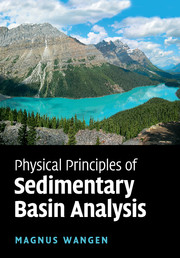Book contents
- Frontmatter
- Contents
- Preface
- Acknowledgments
- 1 Preliminaries
- 2 Properties of porous media
- 3 Linear elasticity and continuum mechanics
- 4 Compressibility of rocks and sediments
- 5 Burial histories
- 6 Heat flow
- 7 Subsidence
- 8 Rheology: fracture and flow
- 9 Flexure of the lithosphere
- 10 Gravity and gravity anomalies
- 11 Quartz cementation of sandstones
- 12 Overpressure and compaction: exact solutions
- 13 Fluid flow: basic equations
- 14 Fluid flow: basic equations
- 15 Wells
- Appendix: Fourier series, the discrete Fourier transform and the fast Fourier transform
- References
- Index
11 - Quartz cementation of sandstones
Published online by Cambridge University Press: 07 May 2010
- Frontmatter
- Contents
- Preface
- Acknowledgments
- 1 Preliminaries
- 2 Properties of porous media
- 3 Linear elasticity and continuum mechanics
- 4 Compressibility of rocks and sediments
- 5 Burial histories
- 6 Heat flow
- 7 Subsidence
- 8 Rheology: fracture and flow
- 9 Flexure of the lithosphere
- 10 Gravity and gravity anomalies
- 11 Quartz cementation of sandstones
- 12 Overpressure and compaction: exact solutions
- 13 Fluid flow: basic equations
- 14 Fluid flow: basic equations
- 15 Wells
- Appendix: Fourier series, the discrete Fourier transform and the fast Fourier transform
- References
- Index
Summary
Sediments are deposited as free or loose particles of a wide range of sizes: mud as fine-grained and sand as coarse-grained particles. When the sediments are buried they get transformed from loose sediments into solid rock by a variety of processes called diagenesis. Mud becomes mudrock or shale, and sand becomes sandstone. This chapter deals with diagenesis of quartzose sandstones, which is among the simplest diagenetic systems, because it basically involves just silica. Nevertheless, it is far from a trivial process and it indicates how complicated diagenesis can be when several minerals are involved.
Introduction
Well-cemented sandstones are really solid rock. There is little pore space left and the original pore space can be filled with so much quartz cement that it amounts to 25% of the bulk volume. There are several explanations for the source of the large amounts of quartz cement often seen. One is that fluid supersaturated with silica has been flowing through the rock, for instance, convective rolls where dissolution takes place in one end of the roll and precipitation at the other. However, this model is shown to be less likely because the number of pore volumes needed to fill the pore space with quartz cement is unrealistically high.
The alternative to silica imported with large-scale fluid flow is a local dissolution–precipitation model. One much-studied model with a local source for silica is the pressure-solution model, where the dissolution takes place in the fluid film between two quartz grains. The fluid pressure in the fluid film between two grains under large stress is larger than the pressure in the pore fluid.
- Type
- Chapter
- Information
- Physical Principles of Sedimentary Basin Analysis , pp. 361 - 384Publisher: Cambridge University PressPrint publication year: 2010



